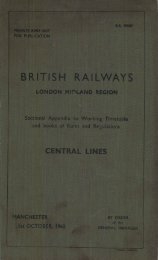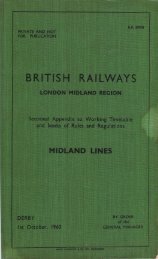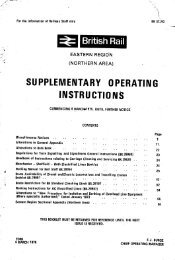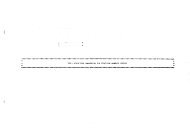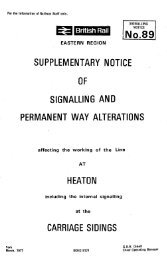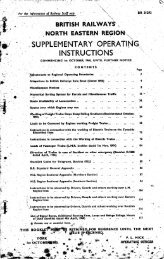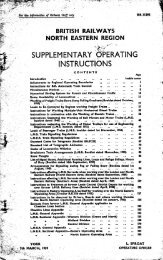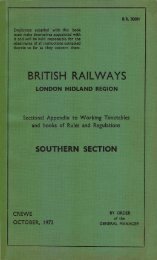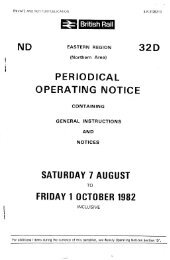general instructions. - Limit Of Shunt
general instructions. - Limit Of Shunt
general instructions. - Limit Of Shunt
You also want an ePaper? Increase the reach of your titles
YUMPU automatically turns print PDFs into web optimized ePapers that Google loves.
General Instructions.—Continued. 1 3 1<br />
Working communication by means of Automatic Brake.—Continued.<br />
in the " brake off" position, so as to bring his large ejector into use and<br />
control the application so far as he can in accordance with paragraph 3 (a).<br />
There is •no sounding instrument in connection with the vacuum brake.<br />
(B. 1575). (O. 1185).<br />
10.--Nearly all Foreign Companies have also had their passenger<br />
vehicles fitted with the apparatus. We may, however, receive odd vehicles<br />
not so fitted, and in these cases care must be taken to see that the vehicles<br />
are not sent forward on N.E. trains which travel more than 20 miles without<br />
stopping. All such cases must be reported to the District Superintendent.<br />
WORKING OF AUTOCARS DURING SNOW3TORMS.<br />
General Rule 165.<br />
During snowstorms when there is a likelihood of the snow falling or drifting<br />
to such a depth as to cover the rails, the operating gear between the engine<br />
and the car must be disconnected, and only the ordinary screw coupling<br />
made use of. The engine under such circumstances must always be attached<br />
in the front of the car. Station Masters at intermediate stations must at<br />
once wire the terminal stations from which the autocar runs in the event<br />
of it being considered necessary to adopt this arrangement.<br />
Particulars of Carriages and other Coaching Stock Vehicles which<br />
may be attached to rear of Passenger Trains ; also particulars<br />
of Cattle Wagons which may be conveyed by Passenger<br />
Trains. G e n e r a l Rules 165 and 194.<br />
1.—The number of carriages or other coaching stock vehicles which may<br />
be attached to a train behind the rear van on the various sections of the<br />
line are as shown on pages 133 to 144.<br />
The term " one carriage or other coaching stock vehicle" means one vehicle<br />
of any description whether bogie, six-wheeled or four-wheeled. (O. 3580).<br />
2.—Where only one vehicle is attached to a train behind the rear 'van it<br />
must be fitted complete with the brake in use on the train, except on parts<br />
of the line where one vehicle fitted only with pipe may be run as the last vehicle<br />
3.—Where more than one vehicle is attached to a train behind the rear van,<br />
the last vehicle must, in all cases, be fitted with the brake in use on the train<br />
complete (except on the portions of the line where a, vehicle fitted with the<br />
pipe only may be run as the last vehicle), and the whole of the other vehicles<br />
must be fitted complete with the brake in use on the train or through pipe<br />
in the proportion laid down in paragraph 1, page 127.<br />
el.—Except on the sections of the line marked with an asterisk (*), one carriage<br />
or other coaching stock vehicle not fitted with the brake complete but fitted<br />
'with the Westinghouse pipe may be attached as the last vehicle of a passenger<br />
-<br />
t,aecordance<br />
with paragraph 1, page 127, and that the number of vehicles,<br />
rincluding<br />
the one fitted only with the pipe, does not exceed the number<br />
allowed behind the rear van under these regulations.<br />
a<br />
i<br />
n<br />
,<br />
p




